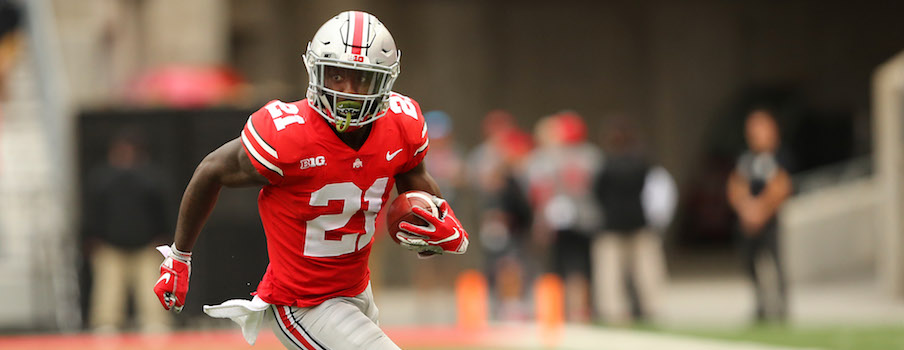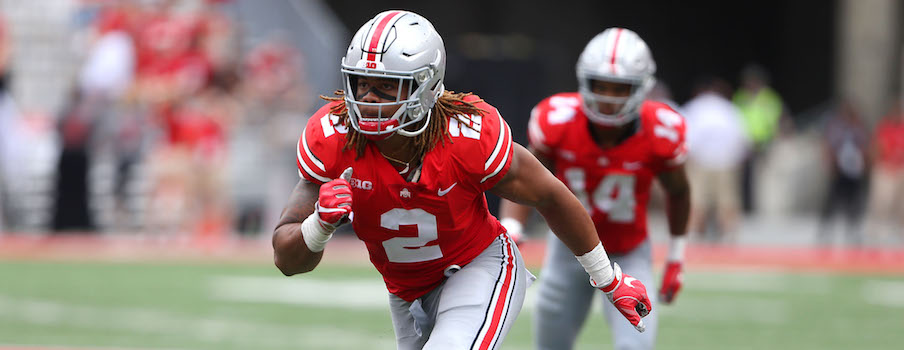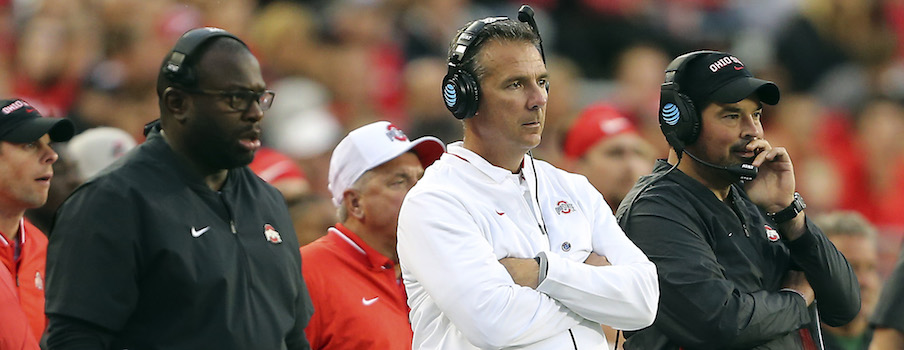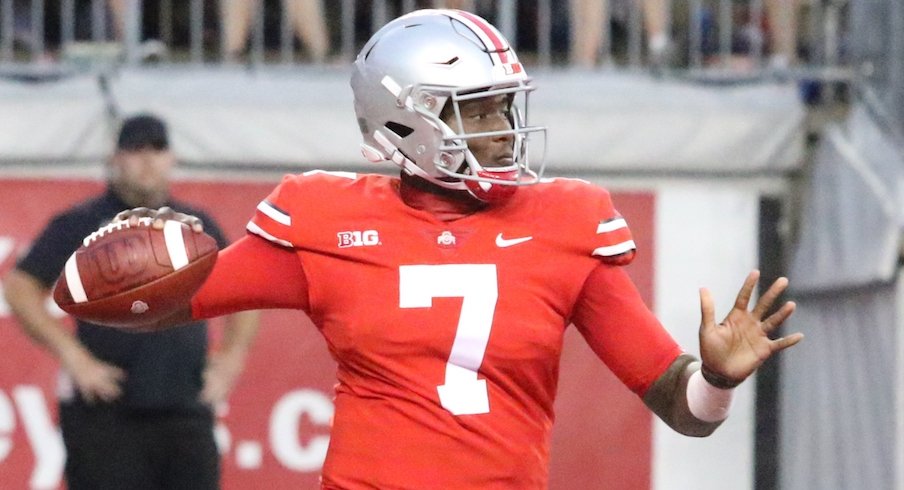With six games in the books and six regular-season games to go, it’s time for a midseason evaluation.
Ohio State has accomplished its most important task so far this season, winning all six of those games, including a pair of challenging contests away from home against TCU and Penn State, along with victories at Ohio Stadium over Oregon State, Rutgers, Tulane and Indiana.
The Buckeyes are 6-0 and ranked No. 3 in the country, leaving all of their goals – which include winning the Big Ten, making the College Football Playoff and competing for a national championship – still achievable in front of them.
Dwayne Haskins has been one of the best quarterbacks in college football, leading the Football Bowl Subdivision with 25 passing touchdowns and ranking seventh in the nation in completion percentage (71.7) and passing yards per game (319.8). The offense ranks fifth nationally in both total yards per game (565.7) and points scored per game (49.0). And Ohio State’s unblemished first half of the regular season came despite a three-game suspension to start the year for head coach Urban Meyer, as offensive coordinator Ryan Day navigated the Buckeyes to their first three wins as interim head coach.
All of that said, there is certainly room for the Buckeyes to improve, and some areas in which they might need to improve to have a chance to achieve those goals. Ohio State head coach Urban Meyer said his team hadn’t “gotten close” to reaching its ceiling or playing its best game after its 27-26 win over Penn State, and that’s still the case after the Buckeyes struggled on defense and running the ball in their 49-26 win over Indiana.
There’s certainly more positives when a team is 6-0, and the following grades are intended to reflect that. But there’s also a high standard for success at Ohio State, where every unit is expected to be among the best in the country and performing at a championship-caliber level, which means the Buckeyes are graded on a steeper curve than most other college football teams would be.
Position Grades
Quarterbacks: A+
We start with the highest grade in the book because in Dwayne Haskins’ first six games as Ohio State’s starting quarterback, he’s performed as well as anyone living within the realm of reality could have expected. He’s already won four Big Ten Offensive Player of the Week awards in just six weeks, has yet to have a bad game and is on pace to shatter Ohio State’s single-season passing records, throwing the ball with a level of effectiveness and efficiency that is legitimately unprecedented at OSU.
Haskins’ downfield passing ability has elevated the Ohio State offense to new heights, and if he can continue to perform at the same level all year as he has in the Buckeyes’ first six games, he’ll have a shot to win the Heisman Trophy and give the Buckeyes a shot to win a national title.
The quarterback grade is based on Haskins’ play, as he’s the only one who’s seen meaningful playing time in close games, but Tate Martell has been impressive in limited action, too, completing 23 of 28 passing attempts for 269 yards and a touchdown while running for another 121 yards and two touchdowns.
Running Backs: B
J.K. Dobbins and Mike Weber haven’t performed badly this season, each rushing for more than 400 yards already, but considering they were expected to be perhaps the best running back tandem in the country, they’ve also been underwhelming.
Dobbins has averaged just 4.67 yards per carry, down from 7.23 yards per carry in 2017, while Weber has averaged 5.68, slightly down from his average of 6.2 from last season. That’s not entirely on them – it’s also on the offensive line, and opposing defenses are able to key in on them as running threats now that the Buckeyes have a starting quarterback who almost exclusively passes the ball.
After a grade-A season last year, though, the running backs’ performance has taken a small step back, and it hasn’t lived up to the hype. They’re certainly not a team weakness, but Meyer hasn’t been satisfied with the performance of Ohio State’s running game, and taking that to the elite level it’s capable of performing at starts with Dobbins and Weber.
Wide Receivers: A
With Zach Smith’s firing less than two months before the season and Brian Hartline’s promotion to interim wide receivers coach in July, the performance of Ohio State’s wide receivers has clearly improved this season. That’s not all because of the coaching change – all of Ohio State’s six wide receivers who play regularly are upperclassmen who likely would have improved anyways, and the way Dwayne Haskins has passed the ball has certainly helped, too – but either way, the development of the receiving corps from an underperforming unit to one of the nation’s best has been noticeable.
Parris Campbell and Terry McLaurin have demonstrably improved as downfield receivers, while Binjimen Victor has finally started to show why Meyer has called him one of the most talented receivers he’s ever had. K.J. Hill has been a consistent weapon from the slot, and Austin Mack and Johnnie Dixon have both had their moments.
The wide receivers are catching the ball more consistently and running better routes, while Meyer has lauded their blocking as “elite.” Meyer said this week that Hartline has done a “great” job this season and that he “sure could” end up earning the full-time wide receivers job by the end of the year.

Tight Ends: C-
Ohio State’s tight ends have continued to be a minimal factor in the passing offense, catching just five total passes for 51 yards in the Buckeyes’ first six games, and they haven’t made a big impact as run blockers, either.
They’ve had their good moments: Rashod Berry had a tremendous effort to block two defenders in different areas of the field on Binjimen Victor’s 47-yard touchdown against Penn State, as detailed by cleveland.com’s Doug Lesmerises. They’ve also their bad moments, like the pass that went off Berry’s hands and into the hands of a Penn State defender for an interception earlier in that game. Mostly, though, they’ve been quiet.
That’s partially a product of Ohio State’s system, which has never emphasized the tight ends as pass-catchers since Meyer arrived in Columbus. They will be expected to move more defenders as blockers, though, to elevate the run game.
Offensive Line: B
Ohio State’s offensive line was one of the biggest question marks entering the season, but it’s performed well for the most part. All five starters have played every one of the team’s meaningful snaps this season, and they’ve surrendered only eight total sacks in six games.
Despite being absolutely massive across the front line, with all five starters weighing at least 310 pounds, the Buckeyes haven’t gotten great push up front, which has led to the decline in performance in the running game. Malcolm Pridgeon and Demetrius Knox have been inconsistent at guard, and Michael Jordan has had issues with low snaps at times, particularly in the TCU game, in his first year playing center.
Altogether, though, the offensive line has been solid, particularly in pass protection, with Thayer Munford playing well at left tackle and Isaiah Prince playing even better in his third season at right tackle. All five starters have had their moments of dominance, and Pro Football Focus ranks the unit as a whole as the sixth-best offensive line in college football so far this season.
Defensive Line: A-
Ohio State’s defensive line is arguably the best in the country, and for the most part, it’s played up to that billing. Nick Bosa, Dre’Mont Jones and Chase Young have all shown their ability to wreak havoc in the trenches, and have all made huge plays.
Bosa recovered a fumble for a defensive touchdown against Oregon State and forced a fumble to set up another for fellow defensive lineman Davon Hamilton against TCU, and Jones returned an interception for a touchdown against TCU, while Young (with help from Jones) made the game-clinching tackle for loss on 4th-and-5 at Penn State.
With the defensive line leading the way, Ohio State ranks second in the nation in sacks (22) and ninth in the nation in tackles for loss (50). That’s even with the best player of the bunch, Bosa, being out since the TCU game after undergoing core muscle surgery.
As talented as they are, though, this unit can be even better. Meyer said this week that the Buckeyes are still expecting more out of their pass-rush, and while the back seven has drawn most of the blame for the big plays Ohio State’s defense has allowed, some of those plays have also resulted from a lack of pressure up front against the pass or a lack of lane discipline by defensive linemen against the run.

Linebackers: C
Halfway through Bill Davis’ second season as Ohio State’s linebackers coach, the play of his unit has continued to underwhelm. Every one of its linebackers who plays regularly has had their share of missed tackles, bad angles to the ball and/or lapses in coverage, leading to many of the big plays that have been hit against the Buckeyes.
There’s been some positives to take away from their play, too. Malik Harrison ranks second on the team with 25 tackles, while Pete Werner has shown his share of playmaking ability, and both first-year starters have drawn considerable praise from Meyer and the rest of the coaching staff. Tuf Borland has gotten better as the season has progressed, forcing key fumbles in each of the Buckeyes’ last two games, after being sidelined for most of the offseason with an Achilles injury.
Still, this unit has been just average, and they have a long way to go to reach Ohio State’s longstanding tradition of great linebacker play.
Cornerbacks: C
With Kerry Coombs and Denzel Ward both now in the NFL, the play of Ohio State’s cornerbacks has taken a step back so far this year, which has been a big reason why the Buckeyes have given up at least 286 passing yards in three of their last four games.
Kendall Sheffield, who was hyped as Ohio State’s potential next first-round cornerback draft pick entering the season, hasn’t played to that level yet. Damon Arnette’s play has continued to be inconsistent. Jeffrey Okudah has been billed as the future star of the group, but he’s also been inconsistent and struggled with pass interference penalties. Shaun Wade has mostly performed well at slot cornerback, but he was burned by Penn State’s KJ Hamler on what turned into a 93-yard touchdown in Happy Valley.
That’s not to say their play has been all bad; negative plays tend to stand out more than positive plays for cornerbacks, and they’ve all had their share of good plays in coverage as well as solid tackling against the run. In a defensive backfield that strives to be the “Best In America,” though, their play hasn’t yet lived up to that billing.
Safeties: D
This grade isn’t reflective of Jordan Fuller, who’s continued to be a stabilizing force on the back end of Ohio State’s defense. He leads the team with 27 tackles despite missing its season opener, and has been the consistent player in the Buckeyes’ secondary.
The second starting safety spot, however, was billed as the Buckeyes’ “No. 1 concern” coming out of spring, and that’s exactly what it’s been this fall. The primary responsibility of a safety, as the name implies, is to prevent big plays on the back end, and neither Isaiah Pryor nor Jahsen Wint – the two safeties other than Fuller who have played regularly – has been able to do that successfully this season.
Pryor has had his ups and downs, but the downs have been pronounced, as he was out of position on both of the 93-yard touchdowns – the longest plays ever allowed by Ohio State’s defense – given up by the Buckeyes this year. Wint, while a solid special teams player, has looked to be in over his head when asked to play a significant role on the defense.
First-year co-defensive coordinator and safeties coach Alex Grinch has to find a way to improve the play at safety – that could mean more playing time for Wade or Amir Riep, who both saw some snaps at safety against Indiana – because it has been a major weakness that has been exposed on a weekly basis on Ohio State’s defense.
Unit Grades
Offense: A
While the Buckeyes are still looking for more out of their running game, particularly in short-yardage situations, and could need it down the stretch, the excellent play of their passing offense has more than made up for it so far. With the exception of their trip to Penn State, the Buckeyes have scored at least 40 points and gained at least 500 yards in each of their other five games this year.
Haskins has taken Ohio State’s passing offense to new heights, and no defense has found an answer to shut it down yet. Ohio State’s offense has a very real case for being the best in the country, and if Weber and Dobbins can really get going in the running game, it has the ability to be even better.
Defense: C
Ohio State’s defense currently ranks 56th in the nation in yards allowed per game (365.2) and 29th in points allowed per game (20), numbers that are not up to the high standards the Buckeyes aspire to. Big plays have been a huge problem for the Buckeyes – they’ve allowed 20 plays of 30-plus yards; only seven teams have allowed more – and have had issues in the back seven that have been recurrent throughout the season, without clear improvement.
All of that said, the defense has done enough for Ohio State to win every game it has played this season, and that’s ultimately what matters. The defense will need to play better down the stretch of the season, though, for the Buckeyes to have a shot at winning a national championship.
Special Teams: B
Ohio State’s special teams haven’t done anything tremendously special this season, but they’ve been solid. The standout of the Buckeyes’ special teams units has once again been Drue Chrisman and the punt team; Chrisman has downed 13 of his 24 punts inside the 20-yard line, averaging 44.4 yards per punt, while the Buckeyes have allowed just 15 punt return yards all year.
The kickoff coverage unit has been substantially better than it was last season, allowing just 15.6 yards per return – ninth-best in the FBS – and no kickoff returns of 30-plus yards yet, though most teams have chosen to fair catch most kickoffs against them.
Sean Nuernberger has only attempted five field goals and made three of them, but he has remained perfect on extra points, making all 39 he has attempted. The Buckeyes’ kickoff and punt return units have continued to underwhelm and haven’t made any game-breaking plays.
But other than some woes with fielding punts early in the season, which have been rectified since K.J. Hill took back punt return duties from C.J. Saunders and Demario McCall, the Buckeyes haven’t made many big mistakes on special teams, making their play in that phase of the game a net positive so far.
Coaching: A
While Meyer has been back on the sidelines since the Buckeyes’ fourth game of the season, his three-game suspension to start the year can’t be forgotten when evaluating their 2018 season, specifically in regards to the job that Day and the rest of Ohio State’s coaching staff did in stepping up and leading the team through fall camp and its first three games while Meyer was away from the team.
That’s perhaps become a forgotten variable in Columbus as the hyperfocus of Ohio State fans has shifted to issues like the team’s struggles on defense, with short-yardage running and with penalties, but the Buckeyes wouldn’t be 6-0 if they hadn’t had a coaching staff that could overcome an enormous distraction in the weeks leading up to the season and keep the team focused and preparing the way they needed to.
Day never looked out of place in his tenure as acting head coach, and the transition back to Meyer as permanent head coach was smooth, too. While it’s fair to question whether some of the coaches have underperformed in leading their units this year, the staff as a whole never allowed the off-field drama to affect what the Buckeyes have done on the field, and that earns them an A grade.

Overall: A-
Can Ohio State beat Alabama, or for that matter Georgia or Clemson? With a mostly weak slate of games remaining on the regular-season schedule, that’s the question that many people are asking, and the root cause of many concerns that fans have about the team despite its 6-0 record.
Even if the Buckeyes make the College Football Playoff, though, they’re still more than two months away from playing any of those teams, so they have plenty of time to improve. For now, they just need to focus on winning each week – which they have so far – to give themselves a chance to get there.
There are areas in which the Buckeyes clearly need to improve, which is they don’t get a straight A on the report card. But they are undefeated, one of the best teams in college football and their chances of winning the Big Ten and earning a playoff berth have only improved since the beginning of the season, which means the positives far outweigh the negatives.


